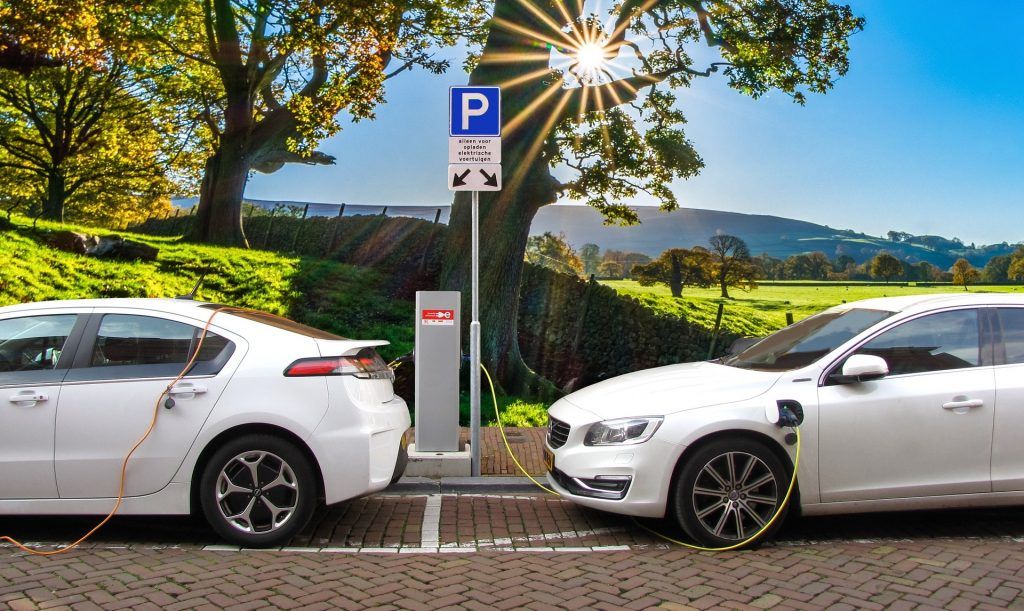Biden’s executive orders on climate: A Green New Deal in disguise?
By Dana Nuccitelli | February 6, 2021
 Photoshopped image of a charging station in Germany for electric cars and an outdoor scene, courtesy of Joenomias/Pixabay
Photoshopped image of a charging station in Germany for electric cars and an outdoor scene, courtesy of Joenomias/Pixabay
Editor’s note: This story was originally published by Yale Climate Connections an initiative of the Yale Center for Environmental Communication.
Imagine a deployment of federal investments to curb US greenhouse gas emissions from various sectors including electricity, transportation, and agriculture, with the goal of creating millions of jobs and an eye on correcting environmental injustices in the process.
It sounds just like what was outlined in the February 2019 House Green New Deal Resolution, but also describes President Biden’s new Executive Order on Tackling the Climate Crisis at Home and Abroad. Although he disavowed the Green New Deal on the presidential campaign trail, Biden’s latest climate executive order adheres closely to its framework.
Though smaller in scale, given that executive orders only apply to federal agency actions rather than the nation as a whole, this effort could reasonably be described as a mini-Green New Deal.

Targeting clean electricity and electric vehicles (EVs). To curb greenhouse gas emissions, the climate crisis executive order targets the electricity and transportation sectors, combined responsible for more than half of American carbon pollution. The order calls on federal agencies to use “all available procurement authorities to achieve or facilitate:
i) a carbon pollution-free electricity sector no later than 2035; and
(ii) clean and zero-emission vehicles for federal, state, local, and tribal government fleets, including vehicles of the United States Postal Service.”
The executive order, applicable only to federal agencies and properties, also notes, “the plan shall recommend any additional legislation needed to accomplish these objectives.” The Environmental Protection Agency can use the order to justify regulating fossil fuel pollution, but given the legal challenges to EPA’s previous power plant greenhouse gas regulation efforts under the Clean Power Plan first launched by the Obama/Biden administration in 2015, reaching the goal of zero emissions from the electricity sector by 2035 may require legislation from Congress. That’s a plausible but challenging prospect.
The directive for government fleets to transition to zero-emissions vehicles may be one of the most consequential components of President Biden’s climate executive orders. The transportation sector accounts for the largest chunk of US greenhouse gas emissions, at 28 percent. Unlike the electricity sector, where emissions have steadily declined over the past decade as coal is replaced by cheaper and cleaner alternatives, transportation emissions remain stagnant at 2005 levels. Electric vehicles over time are expected to substantially reduce the transportation sector carbon footprint, especially when fueled by a steadily cleaner electric grid. But for now, EVs and plug-in hybrids account for just 2 percent of new US vehicle sales. The average lifespan of a passenger car is close to 12 years, so turnover to cleaner alternatives will take time.
However, the federal fleet includes nearly 650,000 vehicles. There are currently 1.4 million EVs (including plug-in hybrids) in the United State, so electrifying the federal fleet would increase that number by nearly 50 percent. The order did not stipulate a timeframe for the transition, or whether federal vehicles will be replaced by EVs once they have reached the end of their lifespans or sooner. Regardless, this federal procurement will create a stable boost in demand for the EV industry and will thus help reduce the costs of the vehicles and key components like batteries.
California Governor Gavin Newsom similarly signed an executive order in September 2020 which mandated that all new passenger cars and trucks sold in the state must be emission-free by 2035. (Large freight-carrying trucks are regulated by the California Air Resources Board.) Massachusetts’ Republican Governor Charlie Baker set the same 2035 target just over a month ago in his state’s Clean Energy and Climate Plan. The auto industry appears to have received the message: Two days after Biden signed his climate crisis executive order, General Motors announced its intent to offer only zero-emissions vehicles by 2035, and GM has begun hiring over a thousand workers at two US facilities to make batteries and EVs.

A focus on climate jobs. At the executive order signing ceremony on January 27, President Biden said, “When I think of climate, I think of jobs,” and that mindset is evident in the orders. Biden took office with the US unemployment rate at 6.4 percent, which is about halfway between the peak of the Great Recession in 2009 (10 percent) and the pre-COVID low of 3.5 percent a year ago. As the country slowly recovers from the coronavirus pandemic, there are still nearly 11 million Americans looking for jobs. Tackling the climate crisis could provide ample employment opportunities.
For example, the executive order calls for the establishment of a Civilian Climate Corps that will create jobs “to conserve and restore public lands and waters, bolster community resilience, increase reforestation, increase carbon sequestration in the agricultural sector, protect biodiversity, improve access to recreation, and address the changing climate.” It harkens back to the Civilian Conservation Corps created in 1933 by President Franklin D. Roosevelt in the original New Deal, which employed 3 million young men over a nine-year period in jobs relating to the conservation and development of natural resources. Green New Deal proponents Congresswoman Alexandria Ocasio-Cortez and Sunrise Movement co-founder Varshini Prakash pushed for the creation of a climate corps from their positions on Biden’s climate task force. Much of the detail on how the new effort will work remain to be determined over the next three months, as cabinet-level positions fill in the blanks.
The order also aims to create jobs in clean technology sectors by stipulating that in making procurement decisions for EVs, clean energy, and energy efficiency, federal agencies will follow Biden’s Made in America executive order, which requires that such products be purchased from American businesses whenever possible.
Environmental justice and natural carbon sequestration. Also like the original incarnation of the Green New Deal, Biden’s climate crisis executive order focuses heavily on environmental justice—directing funding towards communities of color and low-income Americans disproportionately harmed by fossil fuel pollution, and revitalizing communities whose economies and jobs have historically relied on fossil fuels.
The order outlines the administration’s policy “to secure environmental justice and spur economic opportunity for disadvantaged communities that have been historically marginalized and overburdened by pollution and underinvestment in housing, transportation, water and wastewater infrastructure, and health care.” It also establishes the Justice40 Initiative to recommend how federal investments can be made in a way that directs 40 percent of benefits to disadvantaged communities.
The Green New Deal resolution, never passed by the Senate, and Biden’s climate crisis executive order both also call for efforts to remove carbon from the atmosphere and store it in soil and forests by restoring natural ecosystems. In addition to the Civilian Climate Corps, the order calls on the US Department of Agriculture to “encourage the voluntary adoption of climate-smart agricultural and forestry practices that decrease wildfire risk fueled by climate change and result in additional, measurable, and verifiable carbon reductions and sequestration and that source sustainable bioproducts and fuels.”
Climate advocacy groups and Green New Deal advocates like the Sunrise Movement are cheering President Biden’s executive orders and the prioritization of the climate crisis among a broad swath of his administration nominees. Most recognize and reluctantly accept that a full-blown Green New Deal may be out of reach given the divided Senate, but federal agencies can make progress toward its goals by implementing President Biden’s executive orders while congressional Democrats continue to weigh what climate measures they can pass through the budget reconciliation process, infrastructure bills, and foreign aid.

Together, we make the world safer.
The Bulletin elevates expert voices above the noise. But as an independent nonprofit organization, our operations depend on the support of readers like you. Help us continue to deliver quality journalism that holds leaders accountable. Your support of our work at any level is important. In return, we promise our coverage will be understandable, influential, vigilant, solution-oriented, and fair-minded. Together we can make a difference.
Keywords: Biden, Civilian Climate Corps, Climate Day, Green New Deal, climate change, climate crisis, electric vehicles, global warming
Topics: Climate Change














